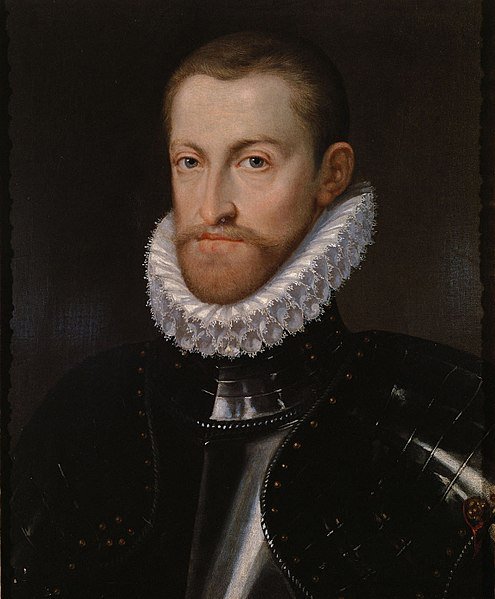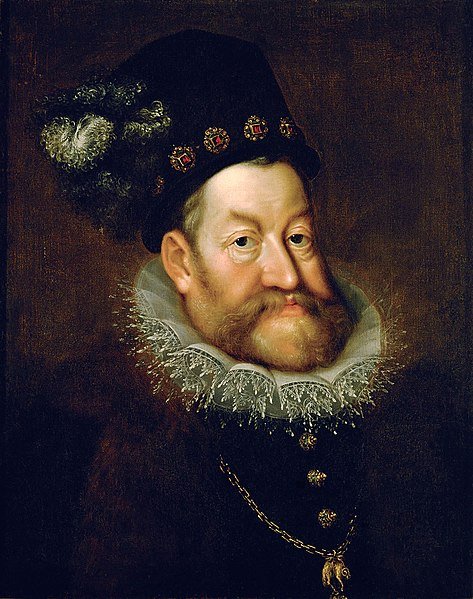Rudolf II was emperor of the Holy Roman Empire and a member of the House of Habsburg, ruling from 1576-1612. In his early years, Rudolf lived in Vienna; at the age of eleven, his family sent the boy to live with his uncle, King Phillip II, in Spain. Due to his strict Catholic education, he had no contact with Protestantism or the ideas of the Reformation. In 1576, as the oldest surviving son of Maximilian II, Rudolf II rose to the throne as Emperor of the Holy Roman Empire. His other titles included King of Bohemia, Hungary, and Croatia; Margrave of Moravia; Archduke of Austria. Many national and familial divisions awaited him once he became Emperor.
Unlike the centralized state of Spain, the Austrian Empire was a loose association of territories that had differing legal traditions, cultures, and languages: nowhere near a centrally governed nation-state. These territories also had differing Christian groups which resulted in constant religious conflict. Although the Habsburg family was Catholic, Rudolf was not religious and refused to support hardline Catholicism. Instead, Rudolf desired to unify Christendom in the Empire and tried to take a tolerant stance on religious issues. For example, he tried to lead a crusade against the Turks in an attempt to give the Empire a unifying cause; however, his efforts ended poorly and led to discontent among his subjects.
Rudolf II as a young man, painted by Martino Rota
Rudolf II was an introverted man who tended to isolate himself, and scholars view his reign as both disastrous and intellectual. Many called Rudolf an ineffectual ruler; instead, he had a love for academics. His dedication to the arts and sciences helped plant the seeds for the Scientific Revolution. In 1583, he moved the imperial court from Vienna to Prague, making it “one of the leading centers of the arts and science on the continent.” Rudolf is “the greatest art patron in the world” as philosophers, painters, alchemists, astronomers, architects, and mathematicians came to Prague to work under his patronage. Unfortunately, the monarchs who succeeded him did not appreciate the art collection he had amassed, and it eventually fell into ruin.
Guiseppe Acrimboldo’s painting of Rudolf II as Vertumnus, the Roman God of Seasons
Portrait of Rudolf II by Hans von Aachen
Throughout most of his life, Rudolf II suffered from poor health. He had syphilis since he was young; most likely being the main cause of his physical and mental illness. Scholars hypothesize the Habsburgs’ history of mental illness (such as schizophrenia and epilepsy) as another possible cause of Rudolf’s depression, anxiety, paranoia, and suicidal ideations. Unfortunately, his poor health hindered him from making decisions and fulfilling his governing duties.
Later in life, succession became an issue of concern; Rudolf had no interest in the marriage that had been arranged for him. Although he had a long-term relationship with non-royal Katharina Strada and reportedly fathered six children, Rudolf did not produce a legitimate successor. In 1600, his relatives decided without Rudolf’s knowledge that Matthias, his brother, would be the next successor to the throne. Matthias had a very hostile view of his brother and held a coup. His brother eroded Rudolf’s power with the help of the royal family, and Matthias was crowned king of Bohemia in 1611. Rudolf retained his title of emperor, but it was an empty title with no real power. After a difficult reign, Rudolf II died in the royal castle in Prague and was buried in the royal crypt in St. Vitus’ Cathedral in 1612.
Written by James Travis
Sources:
Mutschlechner, Martin. “Rudolf II.” The World of the Habsburgs. Schonbrunn Group, 2023. https://www.habsburger.net/en/chapter/rudolf-ii-and-his-socialization-ruler.
Smith, Charlie. “A Mercurial Monarch and His Magical Metropolis.” Central European Yearbook, Vol. 2. University of Minnesota Libraries Publishing, 2020. https://pubs.lib.umn.edu/index.php/cey/article/view/3043.
Vargová, L., Vymazalová, K. & Horáčková, L. “A brief history of syphilis in the Czech Lands.” Archaeological and Anthropoogical Sciences 11, 521–530 (2019). https://doi.org/10.1007/s12520-017-0558-6.
Wise, Jacob. “Prague During the Rule of Rudolf (1583-1612).” The Metropolitan Museum, November 2013. https://www.metmuseum.org/toah/hd/rupr/hd_rupr.htm.



